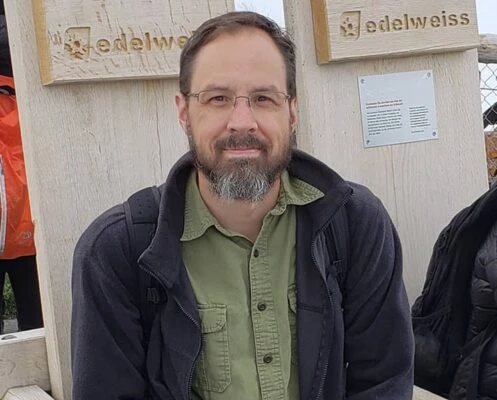
This month’s Apex Magazine cover artist is Lucas de Alcântara. Working with mechanical and organic ideas, and different types of artistic media, he brings a wonderful vision to this month’s Apex Magazine cover. His work as a freelance illustrator, and years of experience as a designer for advertising agencies, lends a unique look to his work.
APEX MAGAZINE: Your cover for this month’s Apex Magazine, “Your touch (or Die Ungeziefer),” expertly mixes organic, mechanical, and ethereal visuals. Did you have a solid vision of the end piece when you started the art, or did the elements evolve as you worked?
LUCAS de ALCâNTARA: Every piece of art I make has some previous small sketches that I do on sketchbooks and loose papers. Then I refine the concepts from the sketches and let them grow a little unleashed, so to say, as I develop them on paper. This piece specifically was based on the “Ungeziefer” concept from Kafka’s Metamorphosis. I defined the composition, color palette, and basic shapes primarily beforehand and allowed the details and variations to be defined during the process.
AM: You took part in the Inktober project late last year, where artists post ink art pieces collaboratively throughout the month of October to social media. Does working on sketch projects like Inktober help to focus the styles you work with, or is it a chance to expand into other ideas and techniques?
LdA: I can’t imagine an artist forging a strong style without a constant change of his ideas and concepts. And I also believe changing techniques can only help one be able to express his ideas and concepts more properly.
Since it’s all an ongoing process, practicing is very important. So Inktober was a fun, but also important motivation for me at this point. It forced me to an almost steam factory production. I was able to reinforce some of my concepts, and leave or assume other characteristics that were filtered in and out during that month.
AM: Your very intricate ink pieces contrast with the softness of many of your watercolor works. Does the detailed crosshatching in your inkwork simply get replaced by color areas in your watercolor pieces, or do the strengths of each medium help you decide how to approach color versus detail?
LdA: Watercolors have, traditionally, looser technique rules. I always try to change that, but the watercolor paint itself has physical characteristics that make it more difficult to tame and add detail. But for me sometimes it suits better to show the mood of my fantasy art, which are always softer than the mood I express with my sci-fi art.
Ink is more straight, driven, decisive.
These are different ways of speaking to different ideas.
AM: On your DeviantArt page, you mention reading stories from Neil Gaiman and Ray Bradbury, and many of your illustrations seem to indicate a greater story behind them. How do those influences affect your art? Vice versa, do the choices you make in creating your artwork affect what you watch or read at any given time?
LdA: Fantasy and science fiction most often are the subjects of my artwork.
I’ve fed on sci-fi for my art since I was a child. The first drawing I remember making was a robot.
What I choose to consume, to watch or read, has a strong influence of my taste, of course, but I’ve always been aware that we need to listen to what other people, especially those outside our friendship circles, have to say in order to form a more solid base of what we take as true, or valid, or sincere, or beautiful, etc. Of course, there are some exceptions, but it works most of the time. Cultures are improved with other cultures more than they are improved by repetition of their own processes. That’s a fact.
AM: The beautiful t-shirt graphics on your DeviantArt page show a similarity in the detailed nature of your works, with a different style to many of your Inktober pieces. Is that based on specific client ideas? Does the production and printing of the t-shirts themselves affect how you create a graphic, whether it be in size of the art, amount of detail, or how easily it can be reproduced?
LdA: T-shirt design has made me reach a level of technique I never would have reached otherwise.
The limitations that the silk-screening process imposes on us, and the high level of fast exposing information it demands, help us simplify some messages we would not be able to illustrate otherwise because of their complexity or depth.
This technique is useful for pop art, for instance.
But I think I’ve managed to use it well in all of my styles.









